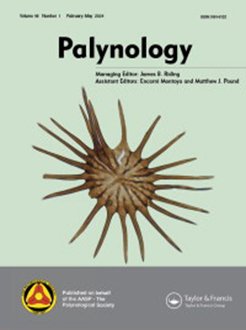The palynological (palynostratigraphical/palynofacies) analysis of samples from the Middle Jurassic outcrop at the Quebrada Álvarez section located in the Neuquén Basin, Patagonia, Argentina, allowed us to begin to evaluate the palaeoecological significance of the recovered palynofloras and their importance in the evolution of these ecosystems, during the transition between the uppermost Cuyo Group and the lowermost Lotena Group. The Lajas Formation, characterised by the palynofacies type A, could be interpreted as a tide-modified delta front environment. The high abundance and diversity of the palynomorphs identified in the studied samples, contribute to improve the palynological knowledge of the Challacó Formation (palynofacies type B – F). Considering the palaeoecological requirements of the recognised plant families, relatively humid and warm climate conditions could be inferred during the deposition of this unit. Also, the ‘seasonally dry (winterwet)’ biome was interpreted for the first time in the Neuquén Basin. Based on selected key taxa a late Bathonian–early Callovian age is proposed for the Challacó Formation at the Quebrada Álvarez section. The palynological material recorded in this unit suggests the development of a lacustrine environment with cycles of relative contraction and expansion of the water body due to fluctuations between relatively dry and wet conditions. The dominance of phytoclasts, mainly opaque particles, and freshwater algae (Botryococcus) in the Bosque Petrificado Formation (palynofacies type G – I) could suggest the development of a freshwater to brackish lacustrine environment. Based on the dominance of the same group of palynomorphs (chlorophyte algae) in the Challacó and Bosque Petrificado formations, similar palaeoenvironmental conditions would be inferred for these units. From a lithofacies analysis point of view, the Challacó and Bosque Petrificado formations show isopic facies associations in the study locality.
How to translate text using browser tools
7 February 2024
Palaeoenvironments and Palaeoclimate of the Uppermost Cuyo Group and Lowermost Lotena Group at Quebrada Álvarez, Picún Leufú Sub-Basin, Patagonia, Argentina: A Preliminary Study Based on Palynology
Amira Celeste Chalabe,
Daniela Elizabeth Olivera,
Marcelo Adrián Martínez,
Carlos Zavala
ACCESS THE FULL ARTICLE
It is not available for individual sale.
This article is only available to subscribers.
It is not available for individual sale.
It is not available for individual sale.

Palynology
Vol. 48 • No. 1
February–May 2024
Vol. 48 • No. 1
February–May 2024
Argentina
biostratigraphy
Bosque Petrificado Formation
Challacó Formation
Lajas Formation
Middle Jurassic
Neuquén Basin





